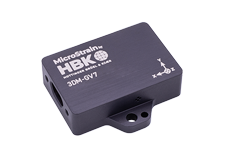FAQs
Videos
The LORD MicroStrain® WSDA-Base-101-LXRS Wireless Analog Output Base Station supports all data acquisition sessions between wireless nodes and host computers including Synchronized Sampling (both Continuous and Burst modes), Armed Datalogging, Datalogging, Streaming and Low Duty Cycle. As an integral feature, the WSDA-Base-101-LXRS has an analog output back panel that supports analog data acquisition equipment (DAQs). Up to 8 sensor channels from one or multiple wireless nodes can be fed into a DAQ with simultaneous digital feed into a PC, or into a DAQ with the PC removed (stand-alone configuration). Each channel on the back panel has a 0 to 3 volt range representing the particular sensor’s full scale output. In some environments and with some equipment, the 0 to 3 volt range is not appropriate; many types of programmable logic controllers (PLCs) and DAQs have only current loop inputs, are therefore incompatible with voltage output sensors, and require a 4 to 20 mA output range to operate. This technical note demonstrates how to convert the 0 to 3 volt output to a 4 to 20 mA output using a third party converter and assumes familiarity with the WSDA-Base-101-LXRS, LORD MicroStrain wireless nodes and Node Commander software.
The LORD MicroStrain V-Link-200 supports a wide range of Wheatstone bridge and analog sensors including acceleration, vibration, strain, load cells, torque, pressure, magnetic fields, displacement, etc.
As a basic function of support for these sensors, the node measures small voltages. The nodes can actually be repurposed to measure small currents. This is useful, for example, if one wanted to add the wireless capability of the nodes to a 4 to 20 mA sensor. See pages 50-51 of the V-Link 200 user's manual http://www.microstrain.com/sites/default/files/v-link-200_user_manual_85... for more information.
Yes, but you must be sure to cut the correct end or the plunger will not work and must be replaced.
1. The M-DVRT plunger has a smaller diameter wire protruding from the end that is not inserted into the DVRT body. This is the end that can be cut. Another way to determine the correct end is to insert the plunger into the DVRT and observe the output. If you get an output change, do NOT cut that end, as it is the end with the ferrite, and the plunger will no longer work if this end is cut. You can use a pair of wire cutters to cut the M-DVRT plunger.
2. The S-DVRT plunger looks like it is plugged at one end and hollow at the other end. The plugged end is the end with the ferrite: do NOT cut that end. Again, another way to determine the correct end is to insert the plunger into the DVRT and observe the output. If you get an output change, do NOT cut that end, as it is the end with the ferrite, and the plunger will no longer work if this end is cut. You can use a dremel tool to cut the S-DVRT plunger.
When cutting the plungers, keep in mind that you want some length of plunger protruding from the DVRT for mounting when it is fully compressed.
The GPS PPS signal is available on pin 7. It can drive one high impedance TTL input.
NMEA packets can be had by putting the 3DM-GX3-35 or 3DM-GX3-45 in GPS Direct mode and manipulating the devices with the GPS manufacturer’s software.
Here are two technical notes which show how this is done:
http://files.microstrain.com/8401-0017-Using-u-blox-Software-3DM-GX3-35-3DM-GX3-45.pdf
http://files.microstrain.com/8401-0013-Outputting-NMEA-Packets-to-GPS-Ready-Software.pdf
NMEA packets can also be generated in the user's own application by gathering the navigation data output by the 3DM-GX3-35 or 3DM-GX3-45 and formatting it into NMEA packets. The inertial sensor feeds navigation data to the host computer, the host computer formats the navigation data into NMEA packets, and sends them out the serial port to a NMEA-ready device.
Plastic shims and shim stock can be acquired from industrial supply houses.
McMaster-Carr offers assortments as shown below.
These may be found at: www.mcmaster.com
Part Number: 9513K42
Type Shim Stock
Material Plastic
Material Type PETG and Polyester
Length x Width 5" x 20"
Specifications Met Not Rated
Assortments Standard Shim Stock
Assortments
Assortment Type Plastic Assortment - 15 Piece
Assortment Contents 1 each of these thicknesses:
.0005", .00075", .001",
.0015", .002", .003", .004",
.005", .0075",
.010" (±10%); .0125",
.015" (±.001"); .020",
.025", .030" (±5%).
The GPS antenna cable that ships with every 3DM-GX3-35 and 3DM-GX3-45 is 3 meters in length.
Cable length is important. The longer the cable, the lower the signal strength. If the user lengthens the cable, the signal strength will diminish. The loss of signal strength can only be empirically determined by trying out a particular installation. Loss of signal strength will manifest itself in the number of satellites seen, quality of data reception from satellites, etc.
No. The GPS Receiver only receives standard GPS signals. It does not receive Differential GPS (DGPS) signals. If the user requires DGPS input, the GX3 will accept DGPS via an external feed and in the case of the 3DM-GX3-45, incorporate it in its Kalman filter processing. To be clear: the on-board GPS will be bypassed in favor of the external GPS.
Wikipedia GPS: http://en.wikipedia.org/wiki/Global_Positioning_System
Wikipedia DGPS: http://en.wikipedia.org/wiki/Differential_GPS
Each device has its own billing plan. This allows the user to upgrade critical devices to prevent service disruption, and select the plan most appropriate for each device's usage pattern. Each upgraded device will have its own base charge, and accumulate additional usage charges based on its plan.
When devices on the basic plan reach their maximum MDP, SensorCloud will reject any further data uploads. Similarly, API calls will be rejected after the allotment is exhausted. All previously uploaded data remains accessible through fastgraph. For upgraded devices, SensorCloud will not reject any requests, but will accumulate additional usage costs. These additional costs are defined in each of the billing plans. Additional costs will appear at the end of the month when the billing cycle is renewed.










